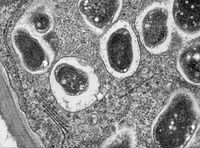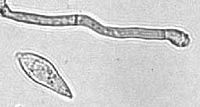
Trichoderma–Azotobacter biofilm inoculation improves soil nutrient availability and plant growth in wheat and cotton
Sign Up to like & getrecommendations! Published in 2019 at "Journal of Basic Microbiology"
DOI: 10.1002/jobm.201900009
Abstract: Microbial biofilms are gaining importance in agriculture, due to their multifaceted agronomic benefits and resilience to environmental fluctuations. This study focuses on comparing the influence of single inoculation—Azotobacter chroococcum (Az) or Trichoderma viride (Tv) and… read more here.
Keywords: inoculation; plant; plant growth; wheat cotton ... See more keywords

Influence of cyanobacterial inoculants, elevated carbon dioxide, and temperature on plant and soil nitrogen in soybean
Sign Up to like & getrecommendations! Published in 2022 at "Journal of Basic Microbiology"
DOI: 10.1002/jobm.202200046
Abstract: Climate change affects nitrogen dynamics in crops and diazotrophic microorganisms with carbon dioxide (CO2) sequestering potential such as cyanobacteria can be promising options. The interactions of three cyanobacterial formulations (Anabaena laxa, Calothrix elenkinii and Anabaena… read more here.
Keywords: plant soil; inoculation; temperature; plant ... See more keywords

Modified distribution in the polyphenolic profile of rosemary leaves induced by plant inoculation with an arbuscular mycorrhizal fungus.
Sign Up to like & getrecommendations! Published in 2019 at "Journal of the science of food and agriculture"
DOI: 10.1002/jsfa.9510
Abstract: BACKGROUND Rosemary forms an arbuscular mycorrhizal (AM) symbiosis with a group of soilborne fungi belonging to the phylum Glomeromycota, which can modify the plant metabolome responsible for the antioxidant capacity and other health beneficial properties… read more here.
Keywords: polyphenolic profile; inoculation; plant; arbuscular mycorrhizal ... See more keywords

An Intradermal Model for Yersinia pestis Inoculation.
Sign Up to like & getrecommendations! Published in 2019 at "Methods in molecular biology"
DOI: 10.1007/978-1-4939-9541-7_1
Abstract: The dermis and the subcutaneous space vary in many fundamental characteristics, which include composition of lymphatic vessels, density of blood vasculature, and cells of the immune response. Traditional approaches employ the subcutaneous space as the… read more here.
Keywords: yersinia pestis; intradermal model; model; inoculation ... See more keywords

Cochallenge Inoculation with Proteus mirabilis in a Murine Transurethral Urinary Tract Model of Ascending Infection.
Sign Up to like & getrecommendations! Published in 2019 at "Methods in molecular biology"
DOI: 10.1007/978-1-4939-9601-8_16
Abstract: Determining virulence factors which contribute to the ability of Proteus mirabilis to establish itself as a prominent cause of urinary tract infections is key in developing targets for potential therapies and treatments. Constructing mutants and… read more here.
Keywords: cochallenge; urinary tract; inoculation; proteus mirabilis ... See more keywords

Inoculation of plant growth-promoting bacteria attenuates the negative effects of drought on sorghum
Sign Up to like & getrecommendations! Published in 2020 at "Archives of Microbiology"
DOI: 10.1007/s00203-020-01810-5
Abstract: Microbial inoculants are suitable cost-effective technology to help plants endure drought. For the development of commercial inoculants, screening of efficient plant growth-promoting bacteria (PGPB) is a crucial step. The aim of this study was to… read more here.
Keywords: inoculation; plant; plant growth; growth promoting ... See more keywords

Response of intercropped barley and fenugreek to mono- and co-inoculation with Sinorhizobium meliloti F42 and Variovorax paradoxus F310 under contrasting agroclimatic regions.
Sign Up to like & getrecommendations! Published in 2021 at "Archives of microbiology"
DOI: 10.1007/s00203-020-02180-8
Abstract: In the present research, we aimed to select efficient rhizobia and plant growth-promoting rhizobacteria (PGPR) from fenugreek nodules and assess their performance as bio-inoculum for intercropped fenugreek and barley. Inoculation effects with selected bacteria were… read more here.
Keywords: variovorax paradoxus; inoculation; meliloti f42; sinorhizobium meliloti ... See more keywords

Biochemical characteristics and inoculation effects of multi-trait plant growth-promoting rhizobacteria on upland rice (Oryza sativa L. cv PSB Rc23) seedling growth.
Sign Up to like & getrecommendations! Published in 2021 at "Archives of microbiology"
DOI: 10.1007/s00203-021-02337-z
Abstract: Plant growth-promoting rhizobacteria (PGPR) are known to stimulate plant growth because of their versatility in nutrient transformation. However, the success of PGPR inoculation depends not only on their ability to promote plant growth but also… read more here.
Keywords: inoculation; upland rice; rice; plant growth ... See more keywords

Impact of Inoculation with Pseudomonas aestus CMAA 1215T on the Non-target Resident Bacterial Community in a Saline Rhizosphere Soil
Sign Up to like & getrecommendations! Published in 2020 at "Current Microbiology"
DOI: 10.1007/s00284-020-02285-9
Abstract: Plant growth reduction caused by osmotic stress, pathogens, and nutrient scarcity can be overcome by inoculation with plant growth-promoting rhizobacteria (PGPR). Knowing the effects of PGPR on the microbial community beyond those on plant growth… read more here.
Keywords: inoculation; community; non; bacterial community ... See more keywords

Nitrogen form and mycorrhizal inoculation amount and timing affect flavonol biosynthesis in onion (Allium cepa L.)
Sign Up to like & getrecommendations! Published in 2017 at "Mycorrhiza"
DOI: 10.1007/s00572-017-0799-3
Abstract: Mycorrhizal symbiosis is known to be the most prevalent form of fungal symbiosis with plants. Although some studies focus on the importance of mycorrhizal symbiosis for enhanced flavonoids in the host plants, a comprehensive understanding… read more here.
Keywords: inoculation; nitrogen form; form; mycorrhizal ... See more keywords

Co-inoculation of Lolium perenne with Funneliformis mosseae and the dark septate endophyte Cadophora sp. in a trace element-polluted soil
Sign Up to like & getrecommendations! Published in 2018 at "Mycorrhiza"
DOI: 10.1007/s00572-018-0826-z
Abstract: The presence of dark septate endophytes (DSEs) or arbuscular mycorrhizal fungi (AMF) in plant roots and their effects on plant fitness have been extensively described. However, little is known about their interactions when they are… read more here.
Keywords: mosseae; inoculation; colonization; dark septate ... See more keywords